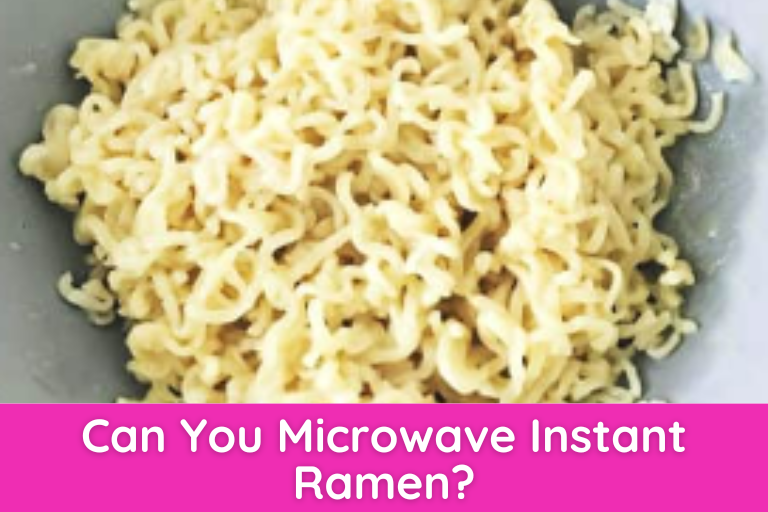When it comes to fast and tasty meals, nothing beats instant ramen. But did you know that it can be microwaved too?
Learn all the tips and tricks for getting perfect, delicious noodles with the convenience of your microwave!
Can you microwave instant ramen cups?
Yes, you can microwave instant ramen cups for a quick and delicious meal. Just follow the directions on the package and experiment with different amounts of water, cooking time, and power levels to get perfect noodles every time!
What happens if you microwave instant ramen?
When you microwave instant ramen, the noodles absorb water and cook through in just a few minutes. Depending on the power of your microwave and time settings, you can achieve perfect texture and flavor that rivals boiling the noodles on the stovetop. It’s important to keep an eye on your noodles while cooking to ensure they don’t overcook or burn.
How do you make instant ramen in the microwave?
Instant ramen in the microwave is a great way to prepare a delicious meal quickly. Here’s how:
- First, remove the cup from its packaging and open the lid slightly so that steam can escape during cooking.
- Place the cup inside your microwave and heat on high for 2-3 minutes, or follow the instructions on the package for specific cooking times.
- Remove the cup from the microwave and close the lid completely before letting it sit for 1-2 minutes. This will allow the noodles to finish cooking as they absorb more water and retain their flavor.
- Finally, carefully open the lid and enjoy!
Is cooking ramen in the microwave safe?
Yes, cooking ramen in the microwave is safe if you follow the instructions on the package and keep an eye on your noodles to ensure they don’t overcook or burn. It’s important to note that some types of instant ramen may not be suitable for microwaves due to their ingredients or packaging. Therefore, always read and follow the directions before microwaving instant ramen.
Is it safe to microwave ramen in a plastic bowl?
In general, it is not recommended to microwave instant ramen in a plastic bowl due to the potential to leak chemicals from the container into the food. When microwaving ramen, it is best to use a microwave-safe ceramic or glass bowl. Also, ensure that any plastic containers you use are labeled as “microwave safe” before microwaving them.
What happens if you put ramen in the microwave without water?
If you microwave ramen without water, it could ignite due to the heat of the microwaves. The noodles may also cook unevenly and become dry and hard. For these reasons, always adding water when cooking ramen in the microwave is important.
How long can you microwave Ramen?
The recommended cooking time for instant ramen in the microwave is usually around three minutes. However, you should always check the instructions on the package for exact times and instructions, as cooking times may vary depending on the type of ramen you are using.
Is boiling ramen better than microwaving?
Boiling ramen is the traditional cooking method, and it can produce a more flavorful and authentic taste than microwaving. Boiling ramen requires more time, and the noodles are cooked in water, which helps them to retain their flavor and texture. On the other hand, microwave cooking takes less time and produces a more external surface, but it can also lead to overcooked noodles. It depends on your preference.
How long does to microwave water for ramen?
The amount of time you need to microwave water for Ramen depends on the wattage of your microwave. For microwaves with 800 or 900 watts, it should take about 1-2 minutes to heat the water to boiling. For microwaves with lower wattages (500-700 watts), it could take between 2-3 minutes. Be sure to adjust the cooking time when heating your ramen water.
How do you cook packaged ramen noodles?
Cooking packaged ramen noodles is easy and takes only a few minutes. Here are the steps:
- Bring a pot of water to a boil.
- Put the noodles into the boiling water.
- Cook for 2-3 minutes until soft, stirring occasionally.
- Rinse the cooked noodles under cold running water and drain them well before eating or adding to a dish.
Why should we not microwave ramen?
Microwaving ramen at high temperatures can cause the noodles to become soggy and the flavor packets to become too salty. Additionally, microwaving ramen can create a mess inside the microwave and disperse an unpleasant smell throughout your home. It would help if you cooked ramen noodles in a pot on the stove for the best results.
Can you eat instant ramen without boiling it?
The short answer is that you should only eat instant ramen after boiling it. Boiling noodles helps to soften them and heat them properly so they will be safe to consume. Eating ramen without boiling it first can cause a potential choking hazard or food poisoning due to the preservatives used in its manufacturing process.
Can you eat ramen without boiling it?
The short answer is that you should only eat ramen after boiling it first. Boiling noodles helps to soften them and also helps to heat the flavor packet, which can be filled with preservatives that need to be cooked before eating. Eating ramen without boiling it can cause a potential choking hazard or food poisoning.
How much should you microwave Ramen?
When it comes to microwaving Ramen, you should follow the instructions on the package. Generally, you will want to place the noodles and flavor packet into a microwave-safe bowl with 2 cups of water and then microwave on high for 3 minutes. After that, you will want to stir and let the noodles sit for 1 minute before consuming.
What is the healthiest way to eat ramen?
The healthiest way to eat Ramen is to make it from scratch. To do this:
- Use whole-grain noodles, low-sodium broth, and vegetables or lean proteins like tofu or eggs.
- If possible, skip the seasoning packet and choose fresh herbs and spices.
- Add plenty of veggies when cooking your ramen – they will provide important vitamins and minerals while also helping you feel fuller on fewer calories.
Is it okay to use tap water for ramen?
Yes, you can use tap water when making ramen. However, if your tap water has an odd taste or scent, it may affect the flavor of your ramen. If this is the case, opt for filtered or distilled water instead.
Conclusion
In conclusion, neuroscience sales tips can be incredibly powerful in driving more customers into your marketing funnel and converting them into sales.
By leveraging the power of cognitive neuroscience principles, you can create a digital marketing strategy that resonates with customers’ brains at different stages in their buying journey and increase your product sales online.
With the right approach, you may even need fewer resources to get better results. Now is the time to explore how these strategies could work for your business!




